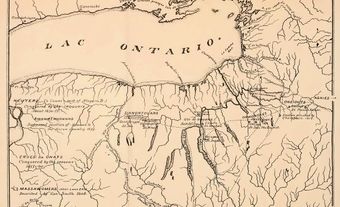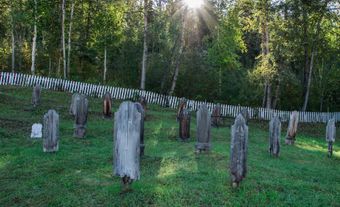
Salvation Army
"Soup to Salvation" was the response of disaffected METHODIST preacher William Booth in 1865 to "the bitter cry of outcast London." From it emerged the Salvation Army, dedicated to physical and spiritual reclamation: "soup" included men's hostels, women's shelters, farm colonies and other similar institutions; "salvation" was preached along Methodist doctrine by an army of officers - with flags, bands and war songs - building their congregations from society's less fortunate. By the century's end the Army had become a permanent feature of English society and had spread to many other countries.The Salvation Army (sometimes referred to as the Sally Ann) officially began its work in Canada in London, Ont, on 1 June 1882. Introduced by fervent believers Mr and Mrs William Freer (Toronto), Jack Addie and Joe Ludgate (London), the Army corps was established in several Ontario towns. By 1886 the Army religion was being practised from Victoria to St John's, although its unusual methods of worship such as the "hallelujah joy-jigs," "free-and-easy meetings," and "noisy open-airs" raised considerable ire and resulted in some legal battles. Eventually, through persistent social welfare work, the Army won nationwide respect.
In 1886 the Rescue Home for "fallen" girls opened in Toronto, followed by similar homes in Winnipeg, Montréal, and Victoria. In 1891 the Army opened its first Prison Gate Home in Toronto to help rehabilitate inmates released from prison, and to assist them with reintegration into mainstream society. Children's shelters, prison farms, and men's hostels were also established, and in 1904 the first Grace Hospital opened in Winnipeg. In 1905 an Army officer became the first Dominion Parole Officer and the Army's first emigrants sailed from England; by 1914 more than 150 000 had settled in Canada under its sponsorship. Salvation Army officers served as chaplains for Canadian soldiers during World War I and World War II, managing programs to provide comfort and support for the troops abroad.
Current Activities
Today the Army continues as a Christian church with an acute social conscience. Its current brand promise is "Giving Hope Today." As the largest non-governmental direct provider of social service, the Army serves about 1.5 million people in Canada each year through a variety of programs. Its 100 000 members in Canada still espouse a Methodist theology with strong adherence to prohibiting alcohol, and expressing their beliefs both in worship and through service to their communities.
Its membership, worship style, and evangelical outreach have designated it as a suburban community church. There are still evangelical pockets of members who call themselves primitive Salvationists and evangelize, as the Army had done in the past, to the underprivileged.
On the whole, most of the corps hold middle-class values and practise a style of worship very similar to other modern evangelical churches. Salvationists are set apart by their uniform (compulsory for officers, less frequently worn by soldiers), by the use of brass bands in their meetings, by their abstinence and non-observance of the sacraments, and by their large number of female preachers. Today the Army's evangelical style is generally less confrontational and aggressive than it was in the past.
The officer-training program under the evangelical wing of the Army has undergone considerable change and now places greater emphasis on academics. The Army has consolidated its training programs from colleges at St John's and Toronto, to one program at Winnipeg. Cadets attend courses offered by the Army's liberal arts institution, William and Catherine Booth College (est 1982). Future Army officers are encouraged to achieve the organization's expectation that each officer earn a bachelor's degree.
The Army's social wing has been affected significantly by government cutbacks and changing social attitudes: one of the most significant changes was the closure of the Women's Social Services at most of its Grace hospitals. As federal and provincial governments decreased their funding to charitable agencies, the Army was forced to withdraw many services offered at the Grace hospitals in Halifax, Labrador City, Calgary, Ottawa, Windsor, and St John's, leaving only Winnipeg Grace and Scarborough Grace as fully-run Salvation Army hospitals. The Army offers continuing and rehabilitative care through the Toronto Grace Health Centre and the Catherine Booth Hospital in Montréal, and four hospices in Calgary, Regina, Richmond, and Winnipeg. It also operates four centres for developmentally delayed adults, 16 long-term care residences for seniors, six multi-service centres for women and single mothers, and two children's treatment facilities.
Apart from these programs, the Army's chief areas of social service are addiction and rehabilitation programs for people addicted to drugs and alcohol; residential services that provide hostels and emergency shelters for men and women in more than 40 Canadian cities; community and family services in approximately 175 towns and cities that distribute food, clothing and furniture to needy families during emergencies; and correctional and justice services including community program centres and residential centres for young adults.
The Army also offers camps for underprivileged children and staffs suicide prevention call centres. Its Red Shield campaigns, Christmas-kettle appeals, and its thousands of civilian volunteers make valuable contributions to many Canadian communities.

 Share on Facebook
Share on Facebook Share on X
Share on X Share by Email
Share by Email Share on Google Classroom
Share on Google Classroom


